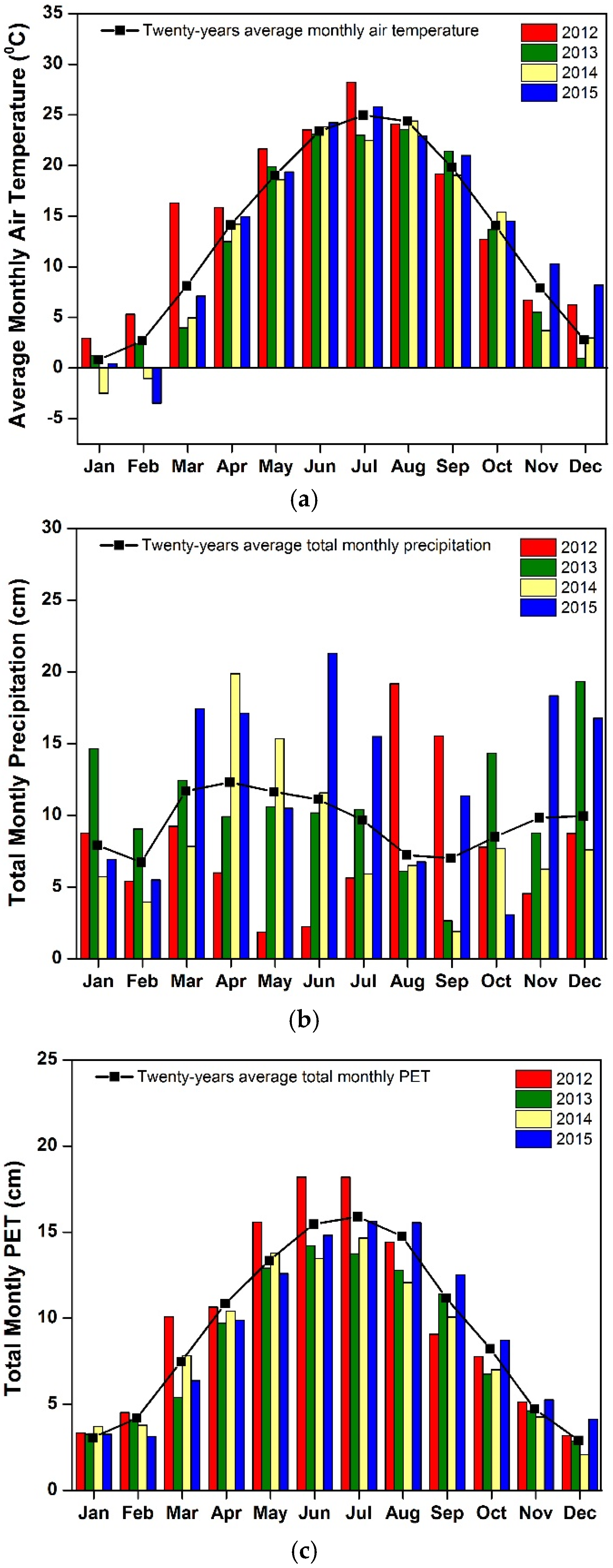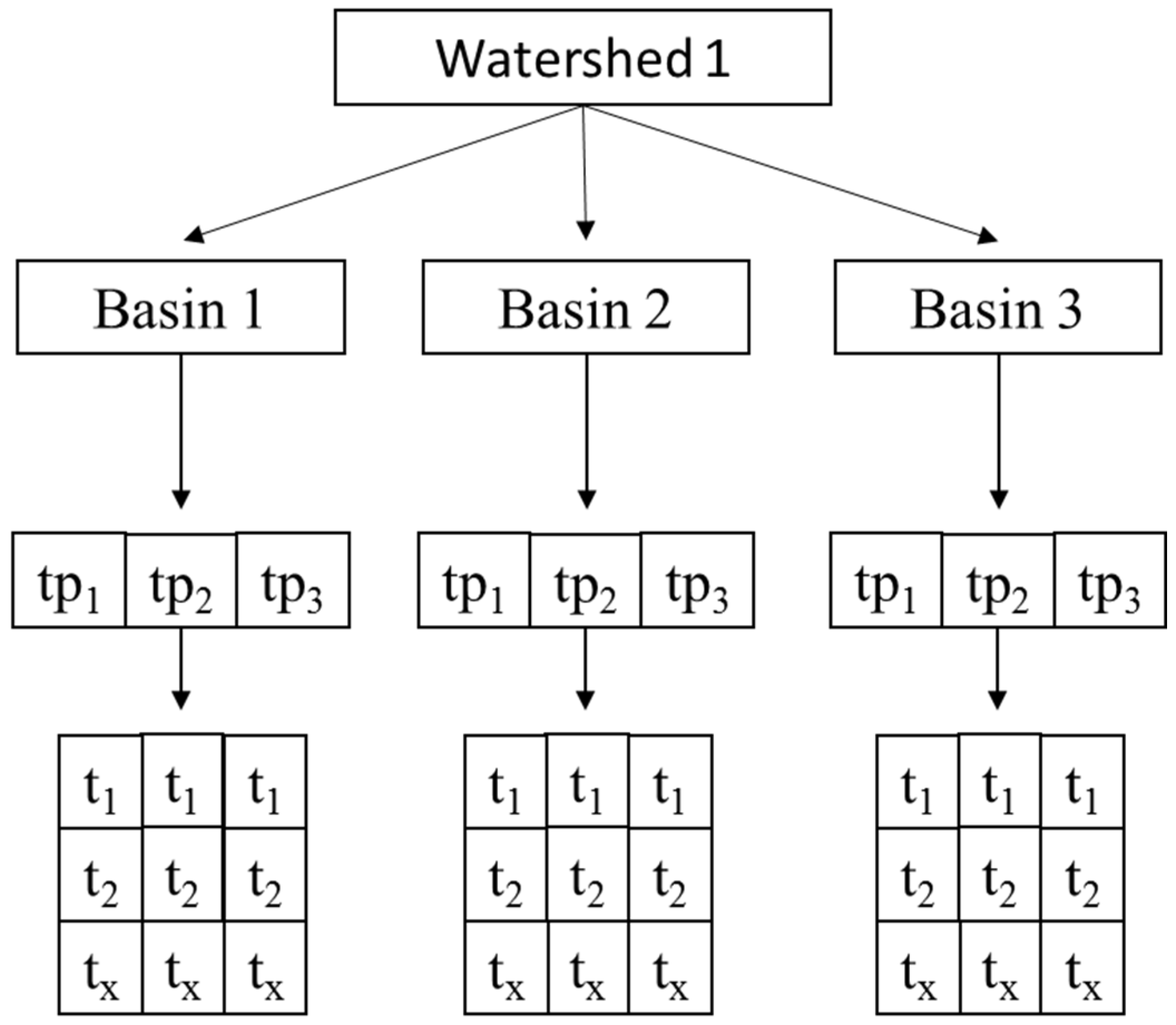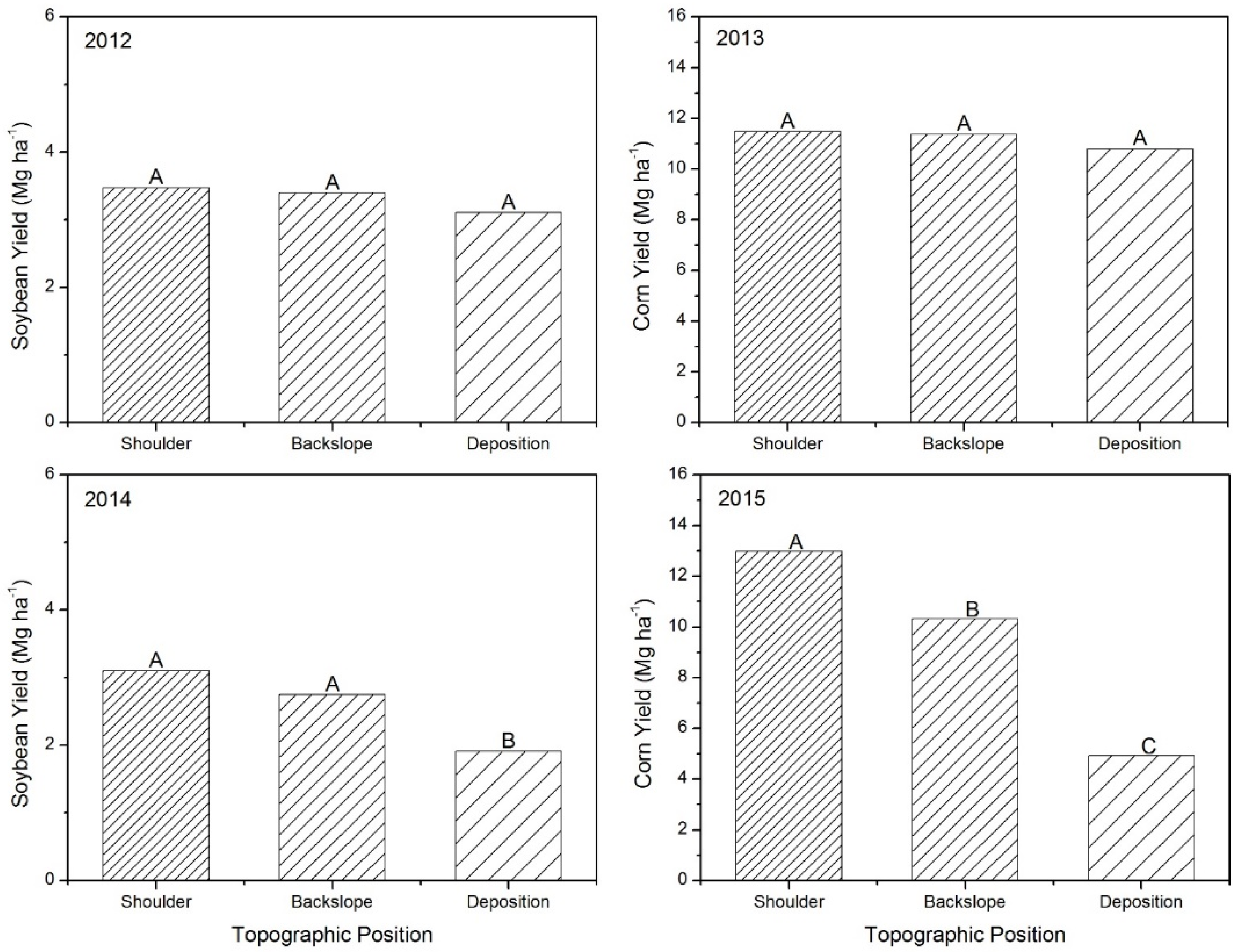3.2. Influence of Topographic Position on Corn and Soybean Yields
There were no significant differences in soybean and corn yields among the three topographic positions in 2012 and 2013. The mean soybean and corn grain yields averaged over all topographic position in 2012 and 2013 were 3.32 and 11.21 Mg·ha
−1 (
Figure 4). In 2014, the soybean grain yield from depositional topographic position was significantly less than shoulder and backslope positions. Soybean yields from the depositional position was 38% lower from than yields from the shoulder position. The mean soybean yields averaged over all topographic positions was 2.59 Mg·ha
−1 in 2014. Soybeans yields were lower in 2014 growing season than 2012 (
Figure 4). In 2015, corn grain yields were significantly different at all three topographic positions. Corn grain yields at the deposition position were 62% and 52% lower than yields at shoulder and backslope positions, respectively. The backslope position resulted in 20% lower corn grain yields compared to the shoulder position in 2015. The annual variability in crop yields can be attributed to weather differences among years. Drier soil conditions resulting from lower precipitation during 2012 might have caused drought stress on soybeans causing lower yields overall, irrespective of topographic positions. The year 2015 was the wettest year compared to other years and may have resulted in different yields at all three topographic positions. Higher precipitation in April and May in 2014 (before soybean planting) as well as during May and June in 2015 resulted in excessive soil moisture conditions which may have caused waterlogging at the deposition position. The anaerobic soil conditions caused by the waterlogged soils resulted in poor plant stand establishment and growth and consequently, lowering grain yields in 2014 and 2015. Soybean is more sensitive to excessive soil moisture conditions compared to corn [
42]. Crop yields were significantly different at topographic position in years with total annual precipitation equal or higher than 20-year average annual precipitation. Dry years showed no differences at various topographic positions. Many studies have shown yearly differences in crop yields due to topography [
18,
19,
43,
44,
45,
46]. In agreement with our results, Muñoz et al. [
44] also reported that topography had major influence on corn yields during the year with higher precipitation. A study conducted by Halvorson and Doll [
29] in eastern Oregon, Washington and North Dakota showed that landscape position and slope aspect significantly influences the grain yield of wheat. Jones et al. [
47] reported that corn, sorghum and soybean yields were also affected by landscape positions and slope length. Thelemann et al. [
48] observed that higher water retention for longer periods of time resulted in lower corn grain and stover yields at depositional and flat areas, whereas well drained summit positions had the highest yields as these slope positions drained earlier. Depression areas can accumulate water in turn they can impact corn and soybean yields and significant difference in yield can be observed during wet and dry years of precipitation in these areas [
46]. Depth to B horizon can play an important role in regulating yields at different topographic positions. Khakural et al. [
45] reported decreased yields of corn and soybean at backslope position compared to foot and upper toe slopes and concluded that it was due to eroded backslope positions. Based on the observed differences in rainfall patterns over 4 years, it is speculated that soil saturation in the early spring may be an important factor affecting differences in N availability to corn and soybean plants among the different landscape positions.
3.4. Influence of Topographic Position on Soil Properties
Sand content at depth 15–30 cm for shoulder position was significantly lower compared to deposition position (
Table 1). Mean silt content at the deposition position was higher than shoulder and significantly higher than at the backslope position for both depths (
Table 1). Mean clay content at depth 15–30 cm for the backslope position (31.874%) was greatest compared to other topographic positions. This could be due to higher percent slope change and more eroded top layer at the backslope position. The deposition position had significantly lower clay content at both depths compared to backslope and shoulder position (
Table 1). At a depth of 15–30 cm, soil pH at the deposition position was significantly higher than the shoulder and backslope positions. However, no significant differences were obtained for soil pH for individual topographic positions between two depths. Total exchanges capacity was highest at the shoulder position at depth 15–30 cm compared to 0–15 cm depth at the shoulder and deposition positions as well as at 15–30 cm depth at the deposition position. At all topographic positions, OM, TN and TC were significantly lower at depth 15–30 cm compared to depth 0–15 cm. At 15–30 cm the deposition position had higher TN and TC than the shoulder and backslope position. Mehlich-3 P and Bray-1 P were significantly higher at 0–15 cm depth at the deposition position compared to other positions except at shoulder position from 0–15 cm depth. Significantly lower P concentrations were evident at the 15–30 cm depth at the backslope position. Physical removal of surface soil from steep slopes may decrease the concentration of N at shoulder position; however, it can rejuvenate the supply of rock derived nutrients such as P at shoulder positions [
51]. At 15–30 cm depth, the shoulder and deposition position had similar Ca concentrations, which were significantly lower from Ca concentrations at backslope position from depth 0–15 cm. The Mg concentration at shoulder position from upper soil layer was significantly lower compared to backslope position Mg concentrations at both depths. Highest Mg concentration was obtained at backslope position from depth 15–30 cm, which was not significantly different to Mg concentration at 0–15 cm depth. The K concentrations were relatively higher at surface layers for all three topographic positions. Lowest K concentration was at 15–30 cm depth from deposition position, which was not significantly different from K concentrations from same depth at the shoulder position. The highest concentration of Na was obtained at the deposition position from depth 15–30 cm which was significantly higher than Na concentrations at 0–15 cm depth from all topographic positions and from 15–30 cm depth from the shoulder position. The S concentrations were significantly higher at the deposition position than both the shoulder and backslope positions for both depths. Concentration of Fe was significantly higher at the deposition position than the shoulder and backslope position for 15–30 cm depth. The highest Fe concentration was obtained within the surface layer of deposition position. The Al concentrations were significantly higher at the lower depth (15–30 cm) for all three topographic positions (
Table 1). Backslope positions have significantly lower Mn concentrations at both depths compared to other two topographic positions. The B concentration showed no significant differences at all positions except at the backslope positon from depth 15–30 cm and at the deposition position at 0–15 cm depth. Surface layers have higher Cu concentrations compare to lower depth 15–30 cm. A study conducted by Wei et al. [
52] found that deposition of eroded soil from upper positions into lower positions of landscape resulted in increase in TC, TN, silt and clay content from upper slope to foot slope along slope position gradients. An increase in soil organic carbon and total P from shoulder slope towards the toe slope in upper 25 cm depth of soil profile was observed by Heckrath et al. [
53]. Yimer et al. [
54] also reported significant differences in soil properties such as soil texture, soil pH, plant available phosphorus, CEC, exchangeable base cations, and percent base saturations. The differences were attributed to topographic aspect-induced microclimatic differences resulting in leaching and OM content differences within soil profile. Slope and aspect can determine the level and location of run-off and infiltration, which can influence the variation in water content and deposition of salts. Salts, pH, Na and CEC levels were observed to be greater in low elevation area when compared to high elevation areas [
49].
3.6. Correlation of ECa with Soil Properties at Three Topographic Positions
A moderate correlation (
r = ±0.50–±0.75) was observed between ECa-H-0.5 and elevation with all basins without topographic separation (
Table 3). However, no significant correlation was observed between ECa-H-0.5 and percent slope for all basins, and a weak correlation (
r < ±0.50) was observed between ECa-H-0.5 and percent slope at the shoulder position. Correlation between ECa-H-0.5 and aspect at the shoulder position was moderate (
r = ±0.50–±0.75) and for all basins with no topographic separation was weak (
r < ±0.50). ECa-H-0.5 at 15–30 cm depth had a moderate (
r = ±0.50–±0.75) correlation with sand at the shoulder position and weak correlation (
r < ±0.50) with sand with all basins combined with no topographic separation. Weak and moderate correlation was observed between ECa-H-0.5 and silt at the backslope and deposition at 15–30 cm (
Table 3). ECa-H-0.5 was weakly correlated (
r < ±0.50) with soil pH from depth 0–15 cm and TEC from depth 15–30 cm, respectively at the deposition position. Combining the data for all topographic positions resulted in weak correlation (
r < ±0.50) of ECa-H-0.5 with soil pH at 15–30 cm depth as well as with TEC at depth 0–15 cm. ECa-H-0.5 was moderately correlated (
r = ±0.50–±0.75) with OM, Ca and S at the depositional position for depth 0–15 cm. ECa-H-0.5 showed weak negative correlation with Al at the deposition position at a depth of 15–30 cm. The negative correlation of Al increased, whereas the positive correlation of Ca and S decreased with ECa-H-0.5 when data were combined over all topographic positions. At the backslope position, TN, TC and Mg showed moderate correlation (
r = ±0.50–±0.75) with ECa-H-0.5 for depth 15–30 cm. Total N and TC was negatively correlated with ECa-H-0.5 at this depth. Mg showed positive and weak correlation for depth 0–15 cm, which improved to moderate correlation (
r = ±0.50–±0.75) if analyzed in absence of any topographic positions. When data were analyzed by removing the topographic positions, the correlations of Na was improved and resulted in moderate correlation (
r = ±0.50–±0.75) with ECa-H-0.5. Mehlich-3 P and Bray-1 P showed a moderate (
r = ±0.50–±0.75) and a moderate to strong correlation (
r > ±0.75) with ECa-H-0.5 for 0–15 cm and 15–30 cm soil depth at the shoulder position, respectively. However, the correlations decreased to weak (
r < ±0.50) when Mehlich-3 P and Bray-1 P were analyzed by combining data over topographic positions. At the shoulder position only, Fe, Ca and Cu showed a significant positive correlation with ECa-H-0.5. The correlation of ECa-H-0.5 with Fe and Cu decreases when data were combined for all topographic positions. The correlation of S at shoulder position with ECa-H-0.5 reversed when data were combined over all topographic positions.
The significant positive correlations of ECa-H-1 was obtained for elevation at the deposition position and the following soil properties: soil pH at deposition positions; clay at the shoulder position for depth 0–15 cm; TEC at the shoulder positions for both depths; Mehlich-3 P, Bray-1 P, and Cu at the shoulder position for both depths; Mg at all three topographic positions for both depths; Na at the backslope position for both depths; S at the deposition position for both depths; K and Fe at depth 15–30 cm and Ca at depth 0–15 cm for the shoulder position; Ca and Na at depth 15–30 cm and K at depth 0–15 cm for deposition positions (
Table 4). The correlation of ECa-H-1 decreased for all ions except Mg and Na. No significant correlation was obtained for Mehlich-3 P and Bray-1 P when data were combined over all topographic positions. Al at 0–15 cm and Fe and Mn at depth 15–30 only showed weak correlations (
r < ±0.50) with ECa-H-1 when data were combined over topographic positions.
The significant and positive correlations of ECa-V-0.5 was obtained for following soil properties: soil pH at all three topographic positions; Mehlich-3 P, Bray-1 P, Ca, Fe and Cu at the shoulder position for both depths; B at the shoulder position at depth 0–15 cm (
r > ±75); Mg at backslope and deposition positions for both depths; Al, Mn and soil pH at depth 15–30 cm for backslope positions; Na at the backslope position; Ca, Na and Fe at the deposition positions at 15–30 cm (
Table 5). Correlations with ECa-V-0.5 decreased for Cu, Mn, Fe, Na and Ca, when data were combined over topographic positions. Correlation improved for Mg at depth 0.15 cm. Correlation of ECa-V-0.5 with TEC and S were only obtained when data was combined over topographic positions.
The soil properties that showed significant correlations with ECa-V-1 were sand at the deposition position at 0–15 cm deep (
r = ±0.50–±0.75); silt at backslope and deposition for 0–15 cm depth (
r < ±0.50); clay at the shoulder position at 0–015 cm (
r = ±0.50–±0.75); TEC, Mehlich-3 P, Bray-1 P, and Cu at shoulder positions for both depths; Mg at all three topographic positions; Fe and K from depth 15–30 cm and Ca at depth 0–15 cm at the shoulder position; Soil pH at depth 15–30 cm for backslope and deposition positions; Al and Mn at the backslope position from depth 15–30 cm; Na at the backslope position; Ca and Fe at the deposition position from depth 15–30 cm (
Table 6). The correlations with ECa-V-1 improved only for Al, Fe at the deposition position and Mg at the shoulder and deposition position when data was combined over topographic positions.
Topographic and landscape properties including elevation, slope, curvature and aspect were weakly correlated (
r < ±0.50) to ECa (shallow and deep) for three different soil textures [
4]. Elevation was negatively correlated to ECa when all basins were combine together and our results were in agreement with results observed by Peralta and Costa [
49]. Results from a multi-state dataset collected by Sudduth et al. [
6] on ECa and soil properties showed weak to moderate correlations of ECa with clay content and CEC across most fields. Correlations of ECa with other soil properties including soil moisture, silt, sand, organic C and paste EC were lower and more variable for the fields across North-central USA [
6]. A positive correlation between ECa and clay content was observed at four of six sites in southern high plains of Texas [
16]. Clay content was not significantly correlated to ECa except for ECa-H-1 and ECa-V-1 at 0–15 cm depth on shoulder position at our research site. In another study, conducted by Carroll and Oliver [
13] moderate and moderate to strong correlation were observed between ECa and soil textural fractions (sand, silt and clay) at two separate research sites. The relations between ECa and the topsoil properties were stronger than those for the subsoil. A negative correlation was observed for sand and bulk density with ECa as large bulk densities were associated with sandy soil [
13]. Heil and Schmidhalter [
55] investigated spatial distribution of clay, silt, and sand/gravel on highly variable landscape in Germany and concluded that clay and sand/gravel were most closely related to the ECa, and observed
R2 values ranging between 0.67 and 0.76. Jung et al. [
3] observed a significant positive correlation of ECa with clay content at 15–30 cm depth and a negative correlation with silt and a weak correlation of ECa with sand.
Many studies reported a correlation between cation exchange capacity and ECa, which can be attributed to clay content in a soil profile [
3,
6,
16]. No significant results were observed in our research study when OM was correlated to ECa in all basins with no topographic separation (
Table 3). In contrast, OM distribution showed highly variable and weak correlation with ECa in study conducted by Sudduth et al. [
6] and by Omonode and Vyn [
56]. A significant Pearson correlation coefficient of
r > 0.70 indicated that ECa could be used to estimate P and K levels [
57] and can be used to map the levels of these nutrients with minimum error [
58]. However, weak (
r < ±50) correlations were observed for ECa with all basins with no topographic separations for Mehlich-3 P and Bray-1 P. Similar results of weak correlation of ECa with P were observed by [
3,
56,
57] for surface soil horizons. When data were separated on topographic positions, a moderate to strong correlation was observed between ECa and Mehlich-3 P, and Bray-1 P for 15–30 cm depth and could be explained by an increased P adsorption to clay content with increasing depth [
3].
No significant correlations were found between ECa and TN, and TC in claypan soils of Missouri [
3]. However, Peralta and Costa [
49] and Neely et al. [
59] observed strong negative correlation of ECa with soil organic matter and inorganic carbon in coarse-loamy Mollisols and clayey Vertisols, respectively. Calcium, Mg and Na were often positively and moderately to strongly correlated to ECa [
16,
58]. Soils at our southern Illinois study sites are in the Hosmer series and are characterized by an Ochric epipedon followed by an argillic horizon, occasional occurrence of fragipans and a fairly well distribution of Ca on all topographic positions (
Table 1). Stronger correlation of ECa with Ca may be explained by its significant distribution over the study site. Electromagnetic techniques have been well noted for mapping of salt-affected soils [
60]. Salts of Na can be an important contributor to salinity in southern and central Illinois and electromagnetic induction techniques have been widely used in mapping these salt affected soils [
61,
62,
63,
64] and a moderate to strong correlation was observed at our research site.










